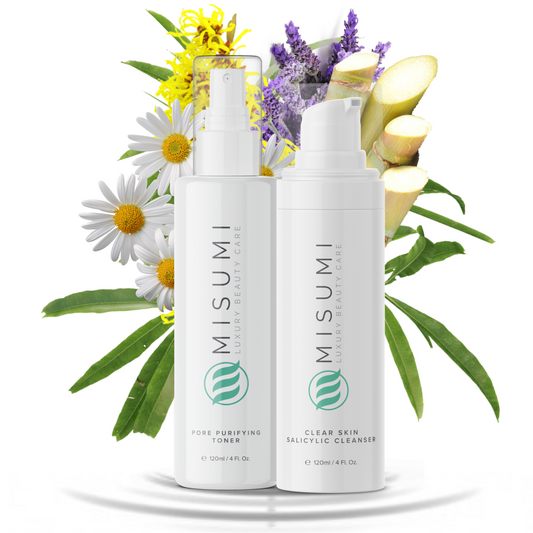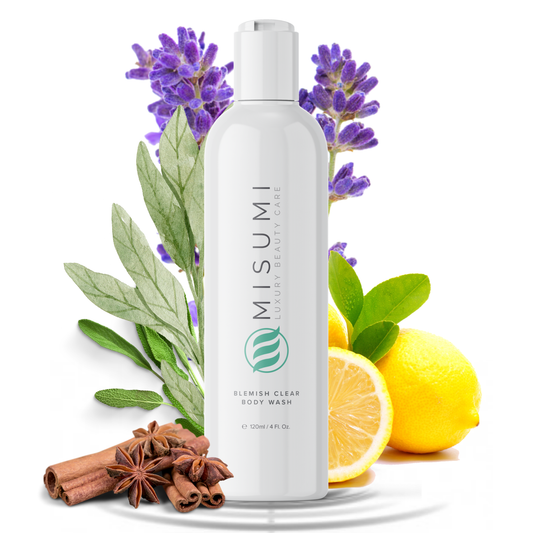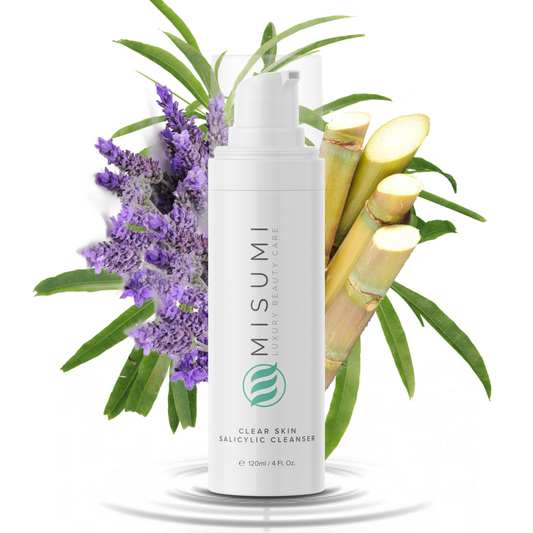Life would be much easier if we could trust the skincare companies responsible for making our skincare products, right? Unfortunately, not all products promote clear skin. (But if you want a trusted product that does, try Misumi's Clear Skin Duo Kit).
We wish we could put all the blame on the big companies and demand more consideration. But the truth is, we all have different skin, and we're all susceptible to different things while resilient to others. If we pair that with the fact that acne is a multifactorial disease involving genetics, hormonal balance, environmental factors, and lifestyle choices, we can understand the struggle to create a product that won't irritate any type of skin.
If you're thinking of using natural ingredients over chemicals, the most natural and pure ingredients (like lemon juice and olive oil can create more damage than any skincare product if not used correctly.
Let us paint you an all too familiar scenario.
You're walking inside your favorite cosmetic store, and you notice the brand you've been loyal to has just launched a new line of oil-free foundation lotions for acne-prone skin. All excited, you buy it, thinking of the smooth skin you'll have tomorrow. But instead, you wake all blemished with a new breakout.

What went wrong?
Many things can go wrong, especially if you're guilty of the three most common skincare sins. It's easy to do; most of us make them without even being aware.
The Skincare Sins Leading To Clogged Pores
Not Knowing Your Skin Type
The first sin people commit is not knowing their skin type. Why is this important? Well, before we continue onto pore-clogging ingredients, we need to address the ingredients that are relatively beneficial for some people while a devil's trap for others. You can't just put anything on your skin.
This is because our physiology is influenced by our unique genetic predisposition and hormone levels. For example, a thick moisturizing agent can be very beneficial to dry skin but just a little too much for oily skin and may clog your pores.
You can't blame the products or ingredients if you don't know your own skin. Fortunately, we've made a practical guide on how to know your skin type that won't take you much time to read but will save you a lot of trouble.

Buying Products that Aren't Suitable
Buying products unsuitable for your skin type is the next major skincare sin.
There are a few reasons why this happens. First, you don't know your skin type. Second, you don't know which ingredients are good for your skin type, or third, you don't really care that much. But, our guess is, if you're here reading about ingredients that clog pores, you must care enough to do the legwork.
Just because the ingredients in the product are FDA-approved and labeled safe, that doesn't mean they are suitable for your skin type. Many skin care products contain comedogenic ingredients.
Comedogenic ingredients are more likely to block pores and cause blackheads. There are different types of comedogenic ingredients, ranging from high to mildly comedogenic. Acne-safe products are more likely to have non-comedogenic ingredients.
Assuming you already know your skin type, you still might not know which ingredients are beneficial for it. Don't worry - we've got you covered here, too. Read about the cosmetic ingredients to look for according to your skin type.
Remember that these are not the same as the pore-clogging ingredients you need to avoid. Many comedogenic ingredients can be beneficial for the skin if used in certain cases. Coconut oil is a good example.
This means you need to learn how to identify pore-clogging ingredients that might be more trouble than they're worth.
Not Using Products Correctly

Today, we have skin care solutions designed to target specific issues and skin ailments. Many are packed with high concentrations of potent ingredients meant to heal, treat, and fix skin issues. So, where's the problem?
Well, by applying a strong product designed to target a specific skin concern, you can easily overwhelm your skin - especially if you apply the product on your whole face rather than on a certain affected area. This is why it's not uncommon to see situations where an acne treatment irritates the skin and causes more breakouts.
To prevent this, check out the instructions. Or, if you're using homemade DIY packs, google the ingredients and learn about them. This will help you better decide the best way to apply them.
For example, lemon juice is best as a spot treatment when diluted, whereas coconut and olive oil are perfect for body use. After using retinol or glycolic acid you must moisturize to prevent drying out the skin. Ingredients like sodium laureth sulfate can also dry out the skin, whereas acetylated lanolin may help. Things like hydrogenated vegetable oil are totally safe to use on the skin..
What Are Pore-Clogging Ingredients, and How Are They Defined?

Pore-clogging ingredients are exactly what they say on the tin. They clog the pores and create a plug inside a hair follicle. Some ingredients can bond with keratin more easily and form a plug, while others can stimulate your glands to produce even more oil.
For these reasons, some common cosmetic ingredients can sometimes be more harmful than beneficial. For example, you may know that coconut oil is responsible for clogging pores, but many others are not so easy to identify. Ingredients like palm oil, cocoa butter, and cotton seed oil may cause breakouts. Wheat germ oil is one of the word offenders of all.
However, argan oil, mineral oil, palmitic acid, sulfated castor oil, and mango butter are non-comedogenic and deemed safe. Opt for oils that resemble the natural oils of the skin.
Nevertheless, we've included a well-researched table that contains pore-clogging ingredients you should look out for and their comedogenic scale. Save it, and use it to check the ingredients whenever you're using a new product.
The Most Common Pore-Clogging Ingredients You Should Avoid

The list below is not exclusive nor definite, but it's scientifically based. All the ingredients we mentioned are well-researched and included in various studies. We've noticed that there are many misconceptions out there and a great deal of confusion about where to find truly comedogenic ingredients.
For example, many people believe that shea butter is comedogenic - which is not true. Shea butter has a comedogenic rating of 0-2. Another controversial ingredient is olive oil, which is relatively comedogenic with a comedogenic rating of 2/3. Using pure, undiluted olive oil can clog your pores, but it's probably safe in products with low concentrations.
To avoid such mistakes or misunderstandings, we played it safe and used a couple of studies to determine which common ingredients have been tested for their comedogenic rating.
According to a study published in the American Academy of Dermatology in 1994, another study published in the Journal of Cutaneous and Ocular Toxicology in 2007, and the Handbook of Cosmetic Science And Technology by Barel, Paye, and Maibach, these are some pore-clogging ingredients to look out for.
|
Ingredients |
Comedogenic Rating |
Potential for Irritation |
|
Oils |
||
|
Cocoa oil |
4 |
0 |
|
Coconut butter |
4 |
0 |
|
Cocoa butter |
4 |
0 |
|
Evening primrose oil |
3 |
2 |
|
Soybean oil |
3 |
0 |
|
Wheat Germ Oil |
5 |
/ |
|
Lanolin and derivatives |
||
|
Acetylated lanolin alcohol |
4 |
2 |
|
Ethoxylated lanolin |
3 |
/ |
|
PEG-16 Lanolin |
4 |
3 |
|
Fatty acids and esters (Surfactants and detergents) |
||
|
Lauric acid |
4 |
1 |
|
Myristic acid |
3 |
0 |
|
Butyl stearate |
3 |
0 |
|
Cetyl acetate |
4 |
2 |
|
Isopropyl isostearte |
5 |
0 |
|
Isopropyl lineolate |
4 |
2 |
|
Isopropyl myristate |
5 |
3 |
|
Isostearyl neopentanoate |
3 |
/ |
|
Isopropyl palmitate |
4 |
/ |
|
Myristyl lactate |
5 |
/ |
|
Myristyl myristate |
5 |
/ |
|
Decyl oleate |
3 |
/ |
|
PPG-2 myristyl propionate |
5 |
/ |
|
Laureth-4 |
4 |
/ |
|
Sodium lauryl sulfate |
5 |
/ |
|
Alcohols, sugars, and their derivatives |
||
|
Isocetyl alcohol |
4 |
4 |
|
Hexadecyl Alcohol |
5 |
/ |
|
Oleyl alcohol |
4 |
2 |
|
Sorbitan oelate |
3 |
0 |
|
Oleth-3 |
5 |
2 |
|
Oleth-5 |
3 |
2 |
|
Laureth 4 |
5 |
/ |
|
Pigments |
||
|
D& C RedNo. 2 |
3 |
/ |
|
D & C RedNo. 6 |
3 |
/ |
|
D & C RedNo. 9 |
4 |
/ |
|
D & C Red No. 19 |
3 |
/ |
|
D & C Red No. 21 |
3 |
/ |
|
D & C Red No. 27 |
4 |
/ |
|
D & C Red No. 30 |
3 |
/ |
|
D & C Red No. 36 |
3 |
/ |
|
Others |
||
|
Algae Extract |
5 |
/ |
|
Carrageenan |
5 |
/ |
|
Red Algae |
5 |
/ |
|
Potassium Chloride |
5 |
/ |
|
Sodium Chloride |
5 |
/ |
Oils
Let's start with the most famous acne-causing ingredients. You don't have to check the ingredients label to know that moisturizers with coconut oil and butter are not acne safe. But have you wondered why that is?
Comedones are clogged hair follicles. This happens when keratin combines with oil. Some oils can create a plug when applied to the face and absorbed into the pores, leading to comedones and acne.
But not all oils are the same. Fortunately, most of them have a well-researched comedogenic rating which can help us figure out which oils are safe and which ones need to be avoided.
Oils can act as amazing moisturizers, packed with powerful vitamins and minerals.
Coconut oil and butter are two examples of highly beneficial and antibacterial oils, but they are still comedogenic ingredients. It's best to use them as a body treatment instead of on the face, as they won't help you get clear skin.
Other oils that could be used in an acne care routine include safflower seed oil, jojoba oil, and sunflower seed oil. Avoid wheat germ oil, soybean oil, and avocado oil. Jojoba oil is especially great, as it's the most similar to our natural oils.

Lanolin and Derivatives
Lanolin is a wax secreted by the glands of wool-bearing animals, like sheep.
High-purity grade of lanolin consists of long-chain waxy esters, lanolin alcohols, lanolin acids, and lanolin hydrocarbons. Because lanolin is composed of long-chain waxy esters, it's used for producing an amazingly high amount of lanolin derivatives.
Being comedogenic and also known to cause allergic reactions, why the heck is lanolin used in skincare products?
According to “The Lanolin Book” from 1999, by authors Hoppe and Beiersdorf, skin bioengineering studies have shown the powerful effect of lanolin as a skin-smoothing ingredient (emollient). Apparently, applying 2 mg/cm2 of lanolin to the skin reduces roughness by about 35% after one hour and 50% after two hours, with the overall effect lasting more than eight hours.
One study from 1996, published in the journal Dermatology Reviews, the so-called "The Lanolin Paradox", showed why this ingredient is considered a topical therapeutic agent and safely used in many cosmetic products worldwide, but it's also linked to adverse reactions, allergies, and acne breakouts.
Whether or not your skin is sensitive to lanolin is still completely personal. However, acne-prone individuals or those with sensitive skin should watch out for lanolin and lanolin derivatives on the product ingredient list.

Fatty Acids and Esters (Surfactants and Detergents)
Surfactants are compounds that lower surface tension - hence their name. The classification of surfactants is diverse. Some surfactants are composed of fatty acid esters of polyhydroxy compounds, like glycerol, sorbitol, sucrose, and others.
In skin care, surfactants are mostly used as detergents for cleansing or emulsifiers in creams and lotions. Cleansing products with mild surfactants can remove surface oil and dirt without compromising the skin's barrier function, which can actually be very beneficial for acne sufferers.
Unfortunately, some fatty acids, esters, and surfactants have been identified as irritants with a high comedogenic rating, which can make things worse.
Be careful of products containing lauric acid, cetyl acetate, isopropyl isostearate, isopropyl lineolate, isopropyl myristate, myristyl lactate, myristyl myristate, or sodium lauryl sulfate.

Alcohols, Sugars, and their Derivatives
Just like oils, acids and alcohols can also have both beneficial and problematic derivatives.
Since we're surrounded with incomplete or misleading information online, it's easy to think that if an ingredient is part of a skincare product, it must be beneficial.
People with oily skin probably love the quick-drying, tight, almost weightless feel that formulas loaded with alcohol (SD alcohol, ethanol, denatured, isopropyl, methanol, or ethyl alcohol) produce. Plus, alcohol is great at increasing the absorption level of other skincare products, which can be beneficial.
However, alcohol is very drying and almost never good for your skin. If used in higher concentrations, it can cause irritation and redness. It also dries the skin very fast, stripping it of its natural oils.
Understandably, this is very damaging to dry skin. But can it control oily skin?
You might think that alcohol is beneficial when you see yourself in the mirror and there's no more greasy shine, but quick drying can provoke the sebaceous glands to go into overdrive. In the long run, this means more excess oil on your face and frequent breakouts.
Isocetyl alcohol, oleyl alcohol, and oleth-3 are the ingredients you should look out for if you have acne-prone, problematic or sensitive skin.

Pigments
Cosmetic and skincare companies use pigments to give color to their skincare and makeup products. If you're a makeup enthusiast, you might know the pigment numbers for each shade of your favorite makeup palette.
However, research has shown that a couple of red pigments are problematic, highly comedogenic, and can contribute to acne development.
Whenever you're buying a skincare or makeup product, check for D & C RedNo. 9 or D & C RedNo. 27. If the product contains these ingredients, your best bet is to stay away from it.
Pore-Clogging F.A.Q.

What If I Have Dry Skin - Should I Avoid Pore-Clogging Ingredients?
It depends. How comedogenic or non-comedogenic an ingredient is won't change, regardless of your skin type. Nonetheless, people with dry skin are probably more resilient and won't be affected as much as people with oily and acne-prone skin.
And here's what's really going on.
People with dry skin usually have very low-active oil glands. This brings other problems, but when it comes to clogged pores, it probably won't lead to acne breakouts.
No acne breakouts won't mean clear pores. Even if the risk for acne is low, your pores can still become clogged.
Why should you care about this?
Well, clogged pores increase the risk of bacteria, viruses, and fungi, causing infection. Additionally, the plug will be noticeable on the surface, which means it will impact your appearance.
Having said that, a product with a low concentration of one or two pore-clogging ingredients probably won't have an adverse effect on people with dry skin. It really depends on the sensitivity of your skin.

My Favorite Product Contains a Pore-Clogging Ingredient. What Now?
We decided to write this article so you can become aware of the pesky little ingredients that might be responsible for your never-ending breakouts. Despite that, you shouldn't take them as rigid rules.
Unfortunately, we can never predict exactly how much these ingredients will influence your condition. Our advice would be to pay attention to your skin.
Here are a couple of questions that might help:
- How does your skin react after applying the product?
- How's your condition when you don't use the product for a couple of weeks?
- Reintroduce the product to your skin after a couple of weeks. How is your skin reacting now?
- Has your condition improved or gotten worse?
- Use the product for a couple of weeks. Are you noticing anything different?

Theoretically, the ingredients mentioned above have the potential to clog your pores and cause problems. They should definitely be on a "watch-out" list for everyone with sensitive, oily, acne-prone, or problematic skin. You can't just put anything on your skin.
That said, you shouldn't discard the product immediately. Instead, use it and if problems emerge, know what to eliminate first.
After all, the concentration and combination of ingredients in one product can change the outcome for better or worse. The comedogenicity of an ingredient is not the same as the comedogenicity of a product.
Many products promote clear skin, such as Misumi's Complete Clear 3-Step System and the AHA 10% Skin Perfecting Cleanser.
Final thoughts? If you have problematic skin, our best advice is to stay educated, make informed choices, and brush up on the ingredients you need to stay wary of. Last but not least - check the ingredient lists!
References
Comedogenicity of current therapeutic products, cosmetics, and ingredients in the rabbit ear










